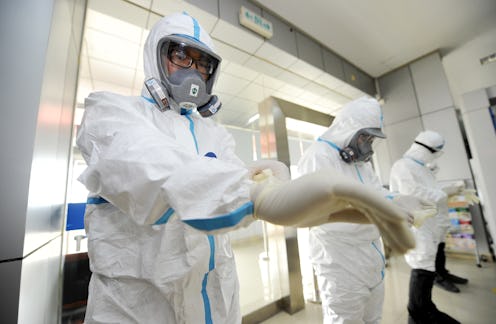News
3 Terrifying Diseases Less Scary Than Ebola
In what's quickly becoming the worst outbreak in modern history, Ebola is projected to infect 20,000 people over the next nine months. While 3,069 cases have been officially logged in the West African countries of Liberia, Sierra Leone, Guinea and Nigeria (and now, the much further removed Democratic Republic of the Congo), the World Health Organization believes that there could be as many as 14,000 actual cases, many of which have simply gone unreported.
The rapidity with which Ebola is spreading has become a profound concern for healthcare workers, especially considering that neither a cure nor a vaccination for the disease exists. However, researchers with the National Institute of Health announced on Thursday that they would begin clinical trials for an experimental Ebola vaccine next week. NIH workers will work alongside pharmaceutical giant GlaxoSmithKline in hopes of finding a solution, and sending it to affected nations as quickly as possible.
Trials for other drugs will also take place outside of the United States, including the United Kingdom, Gambia and Mali. Pressures to conduct tests within the hardest-hit countries, notably Liberia and Sierra Leone, have met with significant resistance from both scientists and drug makers alike, as "the infrastructure in those places would not allow the kind of careful Phase I studies that you would like to do," said Anthony Fauci, director of the National Institute of Allergy and Infectious Diseases in a press conference Thursday.
"Safety is paramount; it’s absolutely paramount," Fauci said, and despite frustrations surrounding the seemingly glacial pace at which the search for a cure is moving, researchers have made clear that their main priority is ensuring that their drug will help, and not further hinder the cause.
This is becoming increasingly important as the death toll resulting from Ebola rises — thus far, 1,552 of the 3,069 infected patients have perished, which represents a fatality rate of just over 50 percent. If Ebola does reach 20,000 individuals in the next nine months, healthcare workers are expecting death tolls upwards of 10,000. This would represent more deaths than all Ebola deaths in the past combined.
Even more concerning are the WHO's reports that "more than 40 percent of the total number of cases have occurred within the past 21 days."
While this Ebola outbreak is certainly not the first deadly disease to sweep through the world in the past few years, it certainly seems like one of the worst. But how exactly does it stack up in comparison?
H1N1 (Swine Flu)
In 2009, the United States braced itself for what was feared to be one of the worst influenza outbreaks in nearly a century (the last occurred in 1918). Swine flu, caused by the H1N1 virus, was so named because pigs carry the virus. However, you cannot contract the disease by eating or handling pork. Rather, swine flu both presents itself and spreads just like the regular flu, but is far deadlier.
The disease first emerged in the U.S. in April, and by June 2009, every single state, as well as Washington, D.C., had reported cases. By the end of the year, it was estimated that the disease had claimed nearly 10,000 lives.
While the total number of cases reported was significantly higher, swine flu could be prevented by a seasonal flu vaccine. More than 85 million swine flu specific vaccinations were made available by year's end, and treatments were largely successful. Less than 0.02 percent of those who contracted the disease died.
Whooping Cough
In 2010, California was struck by the worst outbreak of pertussis, more commonly known as the whooping cough, in 60 years. Described as a "highly contagious bacterial disease" that is transmitted by, you guessed it, coughing, the disease is particularly dangerous to newborns who are too young to receive the vaccination.
Four years ago, California reported a stunning 9,000 cases, at least 10 of which were fatal. All of those who died were infants. As devastating as the whooping cough is, there is a vaccine, and it is a preventable (and treatable) disease.
Severe Acute Respiratory Syndrome (SARS)
Between 2002 and 2003, SARS was a major point of concern in southern China. The disease spread throughout much of the region, and was particularly dangerous in Hong Kong, which ultimately reported the majority of SARS cases.
Essentially an extreme form of pneumonia, SARS gained notoriety for the ease with which it spread. The airborne disease originated in Asia, but quickly made its way to every continent except Antarctica. The disease caused a global panic, particularly due to its relatively high mortality rate of 12 percent. No deaths, however, were reported in the United States.
Older patients were particularly susceptible to the disease, and suffered a mortality rate of 50 percent. Ultimately, over the yearlong course of the outbreak, SARS infected 8,000 individuals and resulted in the deaths of 750, a fatality rate of just over 9 percent.
As devastating as these diseases were, the main differentiator between Ebola and other illnesses remains the lack of treatment. Moreover, the crippling lack of infrastructure and proper facilities in many of the African nations where Ebola is most dangerous has worsened the disease, and made it more difficult to address.
The WHO estimates that a budget of $490 million will be needed in order to properly contain the outbreak, and will require the assistance of NGOs, humanitarian organizations, charities, and governments around the world. Though Ebola currently appears to be contained in Africa, concerns that the cases in Congo are unrelated to those in West Africa may present a more international problem.
With hopes of promising vaccinations soon to arrive, next week just can't come fast enough.
